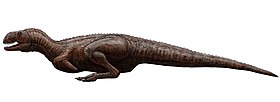Indosuchus
Thank you for being part of the Bharatpedia family! 0% transparency: ₹0 raised out of ₹100,000 (0 supporter) |
| Indosuchus Temporal range: Template:Geological range
| |
|---|---|

| |
| Life restoration in resting pose | |
| Scientific classification | |
| : | [[Template:Taxonomy/Indosuchus]] Huene & Matley, 1933 |
| Species: | Template:Taxonomy/IndosuchusI. raptorius
|
| Binomial name | |
| Template:Taxonomy/IndosuchusIndosuchus raptorius | |
Indosuchus is a genus of abelisaurid dinosaur from the Late Cretaceous Period (70 to 66 million years ago – the Maastrichtian), a theropod related to Abelisaurus. Like most theropods, Indosuchus was a bipedal carnivore. It was about 7 metres long, weighed about 1.2 tonnes,[1] and had a crested skull, flattened on the top. Other authors estimated it to be 9.7 meters in length and 2.3 tonnes in weight.[2]
Naming[edit]
Indosuchus was named by Friedrich von Huene in 1932[3] and was described by Huene and Charles Alfred Matley in 1933 from three partial skulls found by Matley in India near Jabalpur in Madhya Pradesh in strata of the Lameta Formation.[4] The lectotype is GSI K27/685.[5]
The generic name is derived from Indos, Ancient Greek for the Indus and Soukhos, Ancient Greek for the Egyptian crocodile god. The specific name raptorius means "raptorial" in Latin.
Classification[edit]
Because only some skull elements have been found, Indosuchus placement has been somewhat erratic. Although it is now somewhat firmly placed within the Abelisauridae, it was originally assigned by von Huene to the Allosauridae. Alick Walker thought in 1964 it was a member of the Tyrannosauridae. The discovery of other abelisaurids like Carnotaurus has helped clarify its position; in 1986 José Bonaparte concluded it was an abelisaurid.
See also[edit]
References[edit]
- ↑ Paul, G.S., 2010, The Princeton Field Guide to Dinosaurs, Princeton University Press p. 78
- ↑ Molina-Pérez & Larramendi (2016). Récords y curiosidades de los dinosaurios Terópodos y otros dinosauromorfos, Larousse. Barcelona, Spain. p. 256.
{{cite book}}: CS1 maint: location missing publisher (link) - ↑ Huene, F. von, 1932, Die fossile Reptil-Ordnung Saurischia, ihre Entwicklung und Geschichte: Monographien zur Geologie und Palaeontologie, 1e Serie, Heft 4, pp. 1-361
- ↑ F. v. Huene and C. A. Matley, 1933, "The Cretaceous Saurischia and Ornithischia of the Central Provinces of India", Palaeontologica Indica (New Series), Memoirs of the Geological Survey of India 21(1): 1-74
- ↑ S. Chatterjee, 1978, "Indosuchus and Indosaurus, Cretaceous carnosaurs from India", Journal of Paleontology 52(3): 570-580
